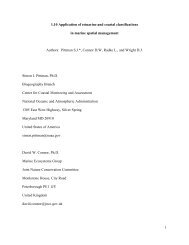Seamounts, Ridges, and Reef Habitats of American Samoa
Seamounts, Ridges, and Reef Habitats of American Samoa
Seamounts, Ridges, and Reef Habitats of American Samoa
- No tags were found...
Create successful ePaper yourself
Turn your PDF publications into a flip-book with our unique Google optimized e-Paper software.
<strong>Seamounts</strong>, <strong>Ridges</strong>, <strong>and</strong> <strong>Reef</strong> <strong>Habitats</strong> <strong>of</strong> <strong>American</strong> <strong>Samoa</strong> 793p0040p0045p0050noted that Rose Atoll is a highly eroded edifice with stellate morphology, suggestingthat it is substantially older than the other volcanoes <strong>of</strong> the <strong>American</strong> <strong>Samoa</strong> province[5]. It is therefore not considered a part <strong>of</strong> the ESVP <strong>and</strong> is perhaps the product<strong>of</strong> either volcanism in the Cook-Austral region or ancient ridge origin <strong>and</strong> platetransport. However, it is included in the discussion <strong>and</strong> map compilation describedbelow by virtue <strong>of</strong> its location. In addition, Swains Atoll, within the unincorporatedUS territory <strong>of</strong> <strong>American</strong> <strong>Samoa</strong>, is located approximately 320 km to the north, farbeyond the extent <strong>of</strong> the ESVP.<strong>Seamounts</strong>, guyots, <strong>and</strong> knolls, with the fluid flow, nutrient supply, <strong>and</strong> modificationto local circulation patterns they provide, are all extremely important habitats(e.g., corals, invertebrates, benthic fish, sea turtles, <strong>and</strong> sharks) <strong>and</strong> may includesome <strong>of</strong> the richest biological “hotspots” in the oceans [6–8]. In the <strong>American</strong><strong>Samoa</strong> region, the most well known <strong>and</strong> spectacular example thus far is Vailulu’useamount at the eastern end <strong>of</strong> the <strong>Samoa</strong>n archipelago, particularly with the hydrothermalvents discovered at its summit <strong>and</strong> rapidly growing Nafanua volcanic conewithin the summit crater/caldera [9–11]. Indeed, seamounts have become priorityhabitats under the Convention on Biological Diversity [12], <strong>and</strong> in 2004 the Oslo–Paris Convention for the Protection <strong>of</strong> the Marine Environment <strong>of</strong> the NortheastAtlantic included seamounts on a list <strong>of</strong> priority habitats in need <strong>of</strong> protection, alongwith other deep-sea reefs, sponge aggregations, <strong>and</strong> hydrothermal vent sites on theMid-Atlantic Ridge [13].At a more local scale, <strong>and</strong> with regard to specific coral reef habitats, this projectfocuses on areas just <strong>of</strong>fshore <strong>of</strong> the isl<strong>and</strong> <strong>of</strong> Tutuila, which is home to the FagateleBay National Marine Sanctuary (FBNMS). Geologically, the shallow flanks <strong>of</strong>Tutuila, <strong>and</strong> <strong>of</strong> the <strong>Samoa</strong>n isl<strong>and</strong>s in general, are characterized by outcrops <strong>of</strong> basalt<strong>and</strong> limestone, biogenic <strong>and</strong> volcanic silt, s<strong>and</strong> <strong>and</strong> gravel, calcareous pavements,<strong>and</strong> calcareous ooze [14]. Many <strong>of</strong> the “cookie cutter” bays that are found along thesouthern coast <strong>of</strong> Tutuila, such as Fagatele Bay, Larsen’s Bay, Pago Pago Harbor,<strong>and</strong> Faga’itua, are thought to be the result <strong>of</strong> volcanic collapse <strong>and</strong> erosion [15].Then, as the isl<strong>and</strong> subsided due to crustal loading, large portions <strong>of</strong> these erodedvalleys were flooded by the sea.A particular emphasis is on underst<strong>and</strong>ing the mesophotic reefs in these areas,mesophotic meaning lower light levels at 30–150 m in the transition from euphoticto dysphotic. Knowledge <strong>of</strong> <strong>American</strong> <strong>Samoa</strong>n mesophotic reefs is very limited, yetthey include the deepest reefs—<strong>and</strong> those most untouched by humans in the archipelago—thushelping to delineate what unimpacted coral reefs are like in the territory[16–18]. Knowledge <strong>of</strong> what natural unimpacted reefs are like in the territoryis very important for gauging the impacts humans have had on reefs at this location.Unfortunately, there are no good examples <strong>of</strong> shallow unimpacted reefs aroundTutuila, where human impacts are greatest. Mesophotic reefs around Tutuila have thepotential to be some <strong>of</strong> the least impacted reefs around Tutuila, <strong>and</strong> thus informationon them is extremely valuable for determining the baseline, <strong>and</strong> the goal for reefmanagement <strong>and</strong> conservation.
















